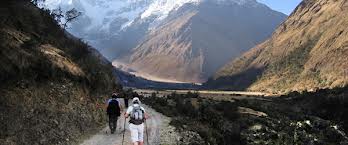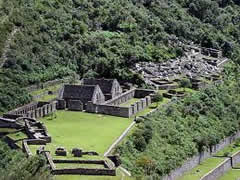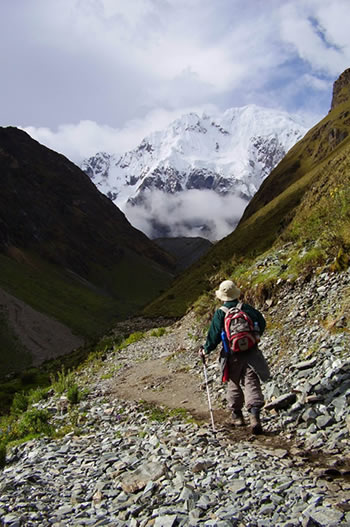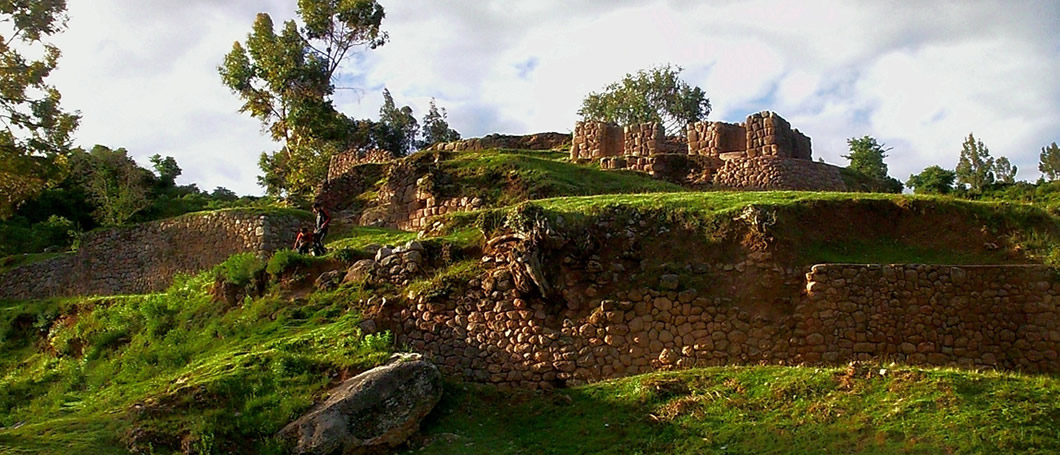CHOQUEQUIRAO HIKE
5 DAYS / 4 NIGHTS
This spectacular hike starts in the village of Cachora, located in the upper parts of the canyon of the Apurimac river. Our group will first descend into the canyon and then climb to the Inca Citadel of Choquequirao.
During the hike we can enjoy the beautiful views over the snowy peaks of the Padreyoc mountain range and the impressive geography of the canyon, which is dry and cold in the upper parts and humid and warm on the lower sections. Due to this variation in the climates we can observe different ecosystems and landscapes while we walk up and down the canyon. There are dry forests, inter-Andean valleys and on the sides of the canyon an oasis similar to the high altitude jungle where the vegetation is mainly the Andean bamboo. Hopefully we will also have the chance to see the biggest flying bird in the planet, the condor which even today plays an important role in the religious Andean rituals.
Day 1 CUSCO-CACHORA-CHIQUISCA (16.60 km)
Early in the morning our private transportation will pick you up from your hotel. Our first stop will be Cachora (2846 masl) a village created during the colonial period when local people were transferred to new places to work there – this is where we start our hike. During the first hours of the walk we will pass through the fields where the local farmers cultivate corn, potato, barley etc. The path will slightly go downhill towards the Capuliyoc pass (2700 masl) from where we can
 can have a spectacular view over the canyon and the road which will take us to our final destination the citadel of Choquequirao. It practically seems to be hanging on the mountainside in the distance.
Later we will descend to the village of Chiquisca (1878 masl) where we will spend the night. During the descent we will see that the landscape is first dominated by Ichu, typical high Andean pastures, and later by dry forests. As we walk down the landscape will become dry and the temperature rises. The mountain Brooks and creeks compensate this dryness and make it possible for the vegetation to thrive and turn the surrounding area into an oasis. These water and temperature conditions allow the local farmers to cultivate certain crops like sugar cane and the production of alcohol from the plant, but of course just on a small, local level.
can have a spectacular view over the canyon and the road which will take us to our final destination the citadel of Choquequirao. It practically seems to be hanging on the mountainside in the distance.
Later we will descend to the village of Chiquisca (1878 masl) where we will spend the night. During the descent we will see that the landscape is first dominated by Ichu, typical high Andean pastures, and later by dry forests. As we walk down the landscape will become dry and the temperature rises. The mountain Brooks and creeks compensate this dryness and make it possible for the vegetation to thrive and turn the surrounding area into an oasis. These water and temperature conditions allow the local farmers to cultivate certain crops like sugar cane and the production of alcohol from the plant, but of course just on a small, local level.
Day 2 CHIQUISCA-CHOQUEQUIRAO (11.17 km)
We leave the camp early in the morning and descend to the Apurímac canyon. After an hour walk we arrive to Rosalinda Beach (1400 masl) and cross through the canyon. Then we ascend through a zigzag path to the Choquequirao Inca settlement (2800m). During the ascent the vegetation will gradually change from dry forests to high altitude jungle. During the hike we can observe the Apurímac canyon, which in Quechua means "Speaking God" and one of the rivers worshipped during the Inca times. Also during the walk we will meet different peasant communities who cultivate sugar cane and produce alcohol from the plant. The climb will finish at the Choquequirao camp site where we spend the night. In the afternoon we will have enough free time to rest and regain our energies for the next day when we visit Choquequirao.
After an hour walk we arrive to Rosalinda Beach (1400 masl) and cross through the canyon. Then we ascend through a zigzag path to the Choquequirao Inca settlement (2800m). During the ascent the vegetation will gradually change from dry forests to high altitude jungle. During the hike we can observe the Apurímac canyon, which in Quechua means "Speaking God" and one of the rivers worshipped during the Inca times. Also during the walk we will meet different peasant communities who cultivate sugar cane and produce alcohol from the plant. The climb will finish at the Choquequirao camp site where we spend the night. In the afternoon we will have enough free time to rest and regain our energies for the next day when we visit Choquequirao.
Day 3 CHOQUEQUIRAO (6,20km)
After breakfast we will devote the whole morning to visiting and exploring the different neighborhoods, temples and places that make up the city terraces  this Inca settlement Choquequirao. We will first see the warehouses of Piquiwasi and later visit the house of the priests from where there is a magnificent view over the canyon. Then we will pass through the Ushno, a ritual platform that dominates the Choquequirao site. We will go across the square and visit the different parts and sections that make up this site: the house of the priests, the house of government, the ceramic workshop area etc. Then we will climb to the higher sections of the complex where we can find ceremonial fountains, warehouses and residential buildings. This will be a trully unforgattable day!
this Inca settlement Choquequirao. We will first see the warehouses of Piquiwasi and later visit the house of the priests from where there is a magnificent view over the canyon. Then we will pass through the Ushno, a ritual platform that dominates the Choquequirao site. We will go across the square and visit the different parts and sections that make up this site: the house of the priests, the house of government, the ceramic workshop area etc. Then we will climb to the higher sections of the complex where we can find ceremonial fountains, warehouses and residential buildings. This will be a trully unforgattable day!
Day 4 CHOQUEQUIRAO COCAMASANA
We leave the camp and walk towards Cocamasana, the place where we will spend the night. We will follow the same path that took us to Choquequirao, first descending to the bottom of the canyon and later starting our climb to Chiquisca. After that we will continue climbing towards Cocomasana (2270 masl) where our overnight camp is.
Day 5 COCAMASANA – CACHORA – CUSCO
Early in the morning we start our ascent to the Capuliyoc pass and from there we walk towards Cachora where our transportation is waiting for the group and take us back to the hotel in Cusco.

¿QUE ESTÁ INCLUIDO?
- Pick-up from your hotel and transfer to the starting point of the trek
- Pick-up from the final point of the trek and return to your hotel
- Accommodation in tents for 2 people – individual tents can be arranged upon request
- Roll-up mattresses
- Dining tent, bathroom tent, tables, chairs and kitchen, cutleries
- English speaking guide, specialized in first aid and CPR
- Support staff consisting of a cook and carriers for handling pack animals
- Five meals a day: breakfast, snacks, lunch, hot drinks and dinner. We can also provide special diets upon request without any additional extra cost.
- Boiled and filtered water throughout the trek, you can fill your bottles after every meal, breakfast, lunch and dinner.
- First aid kit including oxygen bottle
- Entrance tickets to all the archeological areas
- Mules to transport the equipment and food
- A horse in cases of emergencies
What is not included?
- Tips for the personnell
- Any other activity or unexpected event must be paid by the guest himself. In case of medical emergency the guest needs to cover the costs of medical transportation from the mountain to the hospital. Our company is well-prepared to deal with such events in a fast and professional way.
- Sleeping bag
What to take?
- Trekking Boots - rain poncho or waterproof jacket
- Sufficient clothing for the entire trip including warm clothing
- Sandals for use in the camps
- Sleeping bag )
- Torch/Flash light with batteries
- Camera with charger
- Hat or cap - Sunscreen - Insect repellent
- Tissues - Anti-bacterial gel
- Water bottle
- Towels and toilet paper
- Walking sticks/canes
- Extra money is advisable - to take Soles - the local currency - rather than dollars, as there are no facilities to change dollars along the road, ATMs are only available in the town of Aguas Calientes.

